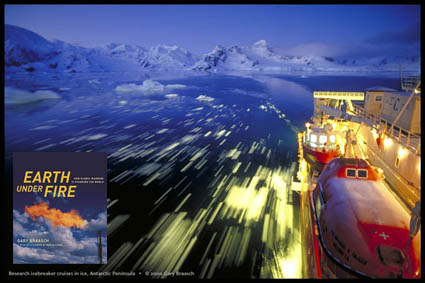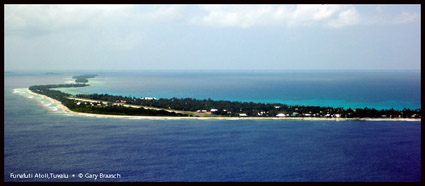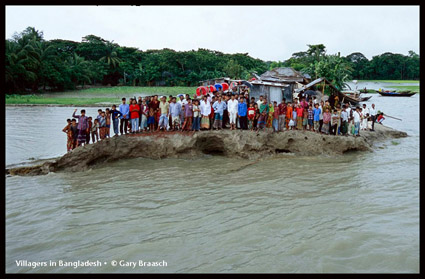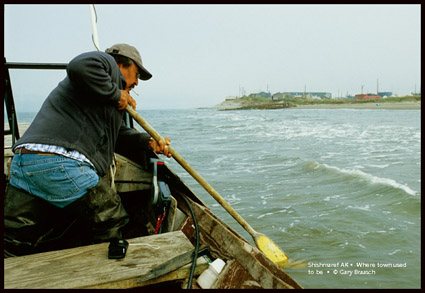Gary Braasch – Acting on Climate Change

Gary Braasch has photographed climate change more extensively than any other photographer. His book Earth Under Fire is a definitive work on the subject.
Find out about Gary Braasch here.
Find out about Earth Under Fire here.
Gary and I have been talking at length on many subjects. Here’s the second installment of our conversations.
John Paul Caponigro
What recommendations do you have for the average citizen to start taking a more active role with respect to these issues? What would you suggest to other photographers to increase the effectiveness of their advocacy efforts?
Gary Braasch
The people I met on my climate change documentary project really mean something to me. Beyond all the scientists and local guides, at this point those who mean the most are the ones who are living with the change but did not cause it …

I am in fact a bit haunted by the Bangladeshis in Mohit’s village, the Inupiats who live with Tony Weyionanna Jr. in Shishmaref Alaska, the kids in Tuvalu and in that coal town in Inner Mongolia. They did not cause the great changes that fossil fuel burning and global warming are bringing, and yet they live right on the edge and are affected far out of proportion to their own energy use.
Yes, it has to be said that everyone (with the possible exception of some jungle tribes still allowed to be in isolation) uses and benefits from fossil fuel and plastics and manufactured goods and land use which contribute to greenhouse gases. Tuvalu, though, uses diesel for its generators, relies on fuel for aircraft and boats, uses a great deal of plastic, etc., but still is the smallest nation in the UN and at the bottom of the UN’s list of climate polluters. Those Bangladeshis on the edge of Bhola Island represent 40 million who earn an average of under $400 a year, compared to $36,000 for an average US citizen. There are about 87 of them on that eroding road, and statistically they equal just one American in CO2 output.
I wish every American and citizen of the other 35 or so nations (out of 191) who create almost all the global warming pollution could feel the presence of the more than five billion people who don’t.

While talking about my books and giving shows around the country, I am asked what should be done. Here is the answer in short form:
1. Understand the problem, its causes and threats.
2. Let leaders know the facts and that you expect them to act.
3. Do something today to reduce greenhouse gas output and energy use.
The hard fact is that despite what many nations, companies, cities and people are starting to do to reduce their global warming emissions, the world is putting more CO2 into the air than ever before. The current amount is 387 parts per million (ppm) — higher than ever in the past 800,000 years.
At the same time, renowned American climatologist Dr. James Hansen of NASA says we already have too much CO2 and other greenhouse gases in the air: “If humanity wishes to preserve a planet similar to that on which civilization developed and to which life on Earth is adapted … CO2 will need to be reduced from its current 387 ppm to at most 350 ppm.”
This number is controversial (many scientists say staying below 450 ppm is acceptable), but there is a general call to act fast — working together as a world of concerned people and leaders taking every action we can to limit greenhouse emissions.
Americans wanting to know more about what the current science says can turn not only to my book, but also to a new report from the federal government, “Global climate change impacts in the United States.” (Available at http://www.globalchange.gov/publications/reports/scientific-assessments/us-impacts). The major points, indicating the on-going changes which I document in World View of Global Warming, are:
Human activities have led to large increases in heat-trapping gases over the past century. The global warming of the past 50 years is due primarily to this human-induced increase. Global average temperature and sea level have increased, and precipitation patterns have changed.
Human “fingerprints” also have been identified in many other aspects of the climate system, including changes in ocean heat content, precipitation, atmospheric moisture, plant and animal health and location, and Arctic sea ice.
In the U.S., the amount of rain falling in the heaviest downpours has increased approximately 20 percent on average in the past century.
Many types of extreme weather events, such as heat waves and regional droughts, have become more frequent and intense during the past 40 to 50 years. The destructive energy of Atlantic hurricanes has increased… In the eastern Pacific, the strongest hurricanes have become stronger since the 1980s, even while the total number of storms has decreased.
Sea level has risen along most of the U.S. coast over the last 50 years, and will rise more in the future. Arctic sea ice is declining rapidly and this is very likely to continue. Global temperatures are projected to continue to rise over this century.
Whether the temperature of the planet rises by 2-3 degrees F or more than 11 degrees in this century depends on a number of factors, including the amount of heat-trapping gas emissions humans continue to allow and how sensitive the climate is to those emissions. Lower emissions of heat-trapping gases will delay the appearance of climate change impacts and lessen their magnitude.
Unless the rate of emissions is substantially reduced, impacts are expected to become increasingly severe for more people and places.
Not a pretty picture. But more and more — in their gardens, along the seashore, in changes to spring and fall natural events, in deeper droughts and more severe weather records, in increasing asthma and urban heat, in smaller glaciers and summer river flow, in dying forests and larger fires – – Americans are seeing climate change and understanding how it affects them.
On my website at http://www.worldviewofglobalwarming.org/pages/actions.html I have a list of “Very Important Things to Do about Global Warming…from the individual to the national. ” These actions are prioritized by those that make the greatest difference and from the individual to the national. For example:
Sell the SUV (Cash for Clunkers!!) and choose cleaner, more efficient vehicles. Reduce your driving: one gallon of gas burned in any car creates 20 pounds of CO2. Slow down for much better mileage. In terms of fuel, if you can, avoid biofuels like corn ethanol that can steal food from a hungry world. Look for ways not only to combine driving trips but also to use more transit and sidewalks for your errands and for getting to school. Electric cars will be coming soon, perfect for urban trips, but any car needs more concrete, which is a heavy climate pollutant. Reclaim our cities for walking, biking, and dense transit networks. More than 40 percent of household energy use is for transport.
Use efficient appliances and use them less, replace light bulbs with low-voltage compact fluorescents, check your home insulation and windows for leaks that can send huge
clouds of heat and CO2 into the air. Many states are offering rebates and programs for household energy audits and rehabs. Turn down the thermostat a few degrees in winter and up a few in the heat of summer. “Smart” meters, offered by many utilities now, can do this for you and help you see how well you are doing. Buy renewable energy, like wind and solar, from your power company, and track the use to see how you can improve. There are also programs for installing solar panels and hot water systems on residences and small businesses. Homes and their contents make 57 percent of household energy use — and half that is for heating and cooling.
Companies — the one you work for and the ones you buy from — can save lots of money and reduce global warming by taking similar steps toward energy efficiency.
Shop smart: Look for products made from recycled materials, created with renewable energy, and which help you save money and reduce pollution. Right now,
WalMart and other companies as well as many product makers, are moving to put energy and climate labels on products so we can all see how what we buy affects our atmosphere and water.Let the corporations who make our cars, fuels, goods and power know you want their products to be as ecological as possible.
Use your vote and influence as a citizen to elect responsive leaders. The US House voted on a heavily compromised energy and climate bill which nevertheless will create
huge incentives for renewable, non-greenhouse-pollution energy and employment. Go visit or write your Senators to urge they strengthen the national law. Coal is a
source of about half our electricity, but it is also the worst CO2 source and very poisonous to boot. Tell your politicians you want to reduce our electrical use so we do not
need coal power in the near future.
Organize the neighborhood and town for energy efficiency. Invite neighbors and schools to cooperate in climate cooling actions: Make pathways for walking and biking; put solar panels on roofs; plant community gardens; combine trips or use electric buses for daily errands and kid transport. For ideas and ways to bring climate knowledge into the
schools, see http://www.howweknowclimatechange.org and http://www.climatechangeeducation.org
In the larger urban areas, suburban sprawl makes for lots of global warming pollution; plan for walkable communities, lots of trees, open spaces, and public transportation in and between cities. Build new homes and buildings for efficiency and solar power. Introduce the LEED building principles into building codes, not just to gain points but to urge the most efficient — even energy generating — buildings from now on. And on the ex-urban front, support sustainable farming and forestry, locally grown foods of all kinds, and non-food crops to make into biofuels.
For concerned photographers, many directions and projects springing from knowledge of climate change can enrich their lives and work and perhaps create a new portfolio. I have encouraged a few energized photographers, such as Benj Drummond and Sara Steele, who wanted to specialize on climate change. Their focus on human societies and groups in “Facing Climate Change” has been very successful. But on an everyday scale, if the issue affects your life or your photo subject matter, just integrate it into your work and make sure your viewers know why you made the photos. Make it personal – it is your subject matter and perhaps your livelihood. Start at home or in places you know well, with local effects and local reactions. Since we must all be on to the changes, the things people are doing to shift energy use and waste are extremely important. Many groups from traditional outdoor clubs to fire departments and military bases are taking up climate change — they need photos and we need to see what they are doing. Climate change affects everyone and everything.
Stay tuned for more with Gary in the coming weeks.



No Comments